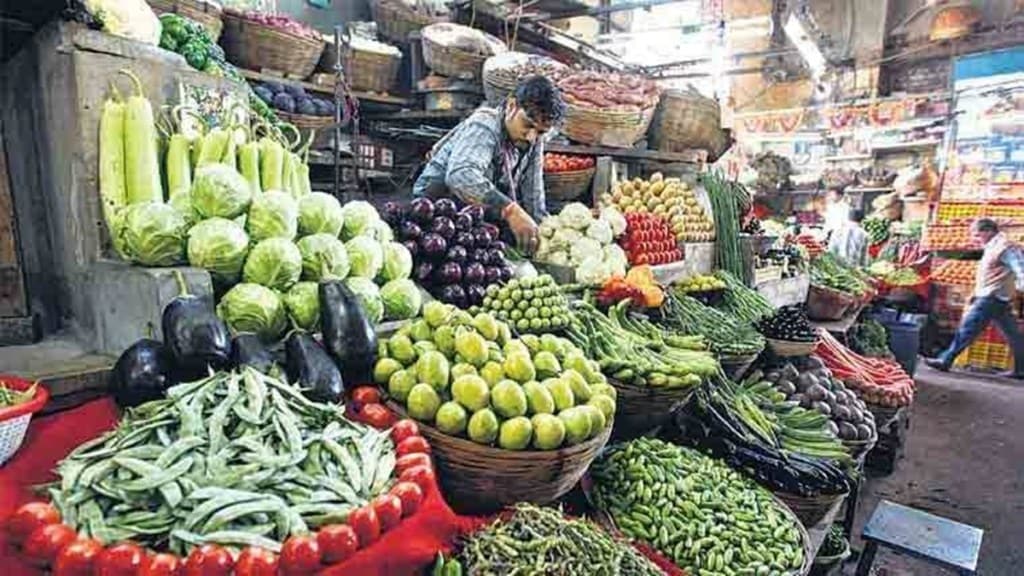Retail inflation, measured by consumer price index (CPI), fell to a one-year low of 5.72% in December, thanks primarily to a sharp deflation (-15.08%) in vegetables and easing of price pressures in the broader “food and beverages” category, according to official data released on Thursday. The inflation stood at 5.88% in November 2022.
With this, the headline inflation number remained below the upper limit of the Reserve Bank of India’s (RBI’s) medium-term target of 2-6% for the second straight month (it was previously above that range for 10 long months).
Also read: Economists forecast 6% GDP growth next fiscal
Though the latest inflation print was significantly below analyst expectations, it is unlikely to prevent the RBI from going in for the sixth round of rate hike in February, which is widely expected to take the policy repo rate to 6.5% from 6.25% at present.
Persistently high “core inflation” – it inched up to 6.1% in December from 6% in November – remains a cause for concern, along with still-elevated inflation rates for “fuel and light” (10.97%) cereals (13.79%), “milk and milk products” (8.51%) and “clothing and footwear” (9.58%) categories. Inflation, measured by the consumer food price index, saw a sharp sequential decline from 4.67% in November to 4.19% in December.
In its latest monetary policy statement, the RBI said: “The correction in industrial input prices and supply chain pressures, if sustained, could help ease pressures on output prices; but the pending pass-through of input costs could keep core inflation firm.”
Wholesale price inflation had hit a 21-month low of 5.85% in November, aided by a favourable base and a sharp drop in food inflation. It was for the first time since February 2021 that inflation measured by wholesale price index fell below the retail inflation rate, suggesting the pass-through of elevated input costs to finished product prices was nearing completion.
Though the relatively benign global commodity prices and a favourable base will likely continue to ease retail inflation in the short term, the outlook is still rather uncertain. The price pressures in the economy in the next fiscal will be influenced by how geopolitical factors will pan out. The economic slowdown in China and its impact on supply chains coupled with the impending recession in the West will potentially have a major role in imported inflation.
That said, retail inflation for Q3FY23 came in at 6.1%, half a percentage point below the RBI’s forecast. This means that the inflation forecast for FY23 will be significantly lower than 6.7% seen by the RBI and the monetary policy committee (MPC). Analysts reckon that CPI inflation in Q4 will be marginally below 6% and that in Q1FY24 could come in at below 5%.
Also read: Borrowers can save 20-25% on EMI obligations with FREED’s Debt Consolidation Program: CEO
Data released by the ministry of statistics and programme implementation on Thursday revealed that the “food and beverages” sub group, which has a 45.86% weight in the combined CPI basket, registered deflation in vegetables for the second straight month although inflation in cereals and products remained high at 13.79%.
Significantly, CPI inflation in health and education also picked up, indicating higher fees and costs. While CPI inflation in health rose to 6.15% in December, it increased to 5.9% in education.
“This (core inflation) will remain sticky as the government is not lowering excise duties on fuel, while companies are still in the process of passing on the higher input costs,” said Madan Sabnavis, chief economist, Bank of Baroda, adding that RBI may continue to increase rates in the February policy by 25 basis points, which can be the last hike for this cycle as the numbers in the coming months would come down due to the base effect.
Suman Chowdhury, chief analytical officer, Acuité Ratings & Research said: “While RBI is expected to review its inflation forecast in the next MPC meet, we believe that the likelihood of a lower average inflation for FY23 as a whole vis-à-vis our forecast of 6.7% has increased,” he said.
In its December policy, the MPC had expected retail inflation to moderate to 5.9% in the fourth quarter of the fiscal.
Sunil Sinha, principal economist, India Ratings, however, noted that this is the fourth consecutive quarter of more than 6% inflation. However, it has declined from 7.28% in the first quarter of the fiscal to 7.04% in the second quarter and 6.12% in the third quarter.
“Although impact of monetary policy will gradually start reflecting in cooling down of retail inflation in the coming months and the same is expected to drop to about 5% by first quarter of FY24, Ind-Ra still sees a strong possibility of 25 basis point rate hike in February 2023 monetary policy committee review meeting,” he said.
Pertinently, for the 40th month in a row, retail inflation remained higher than the the RBI’s medium-term target of 4%.

